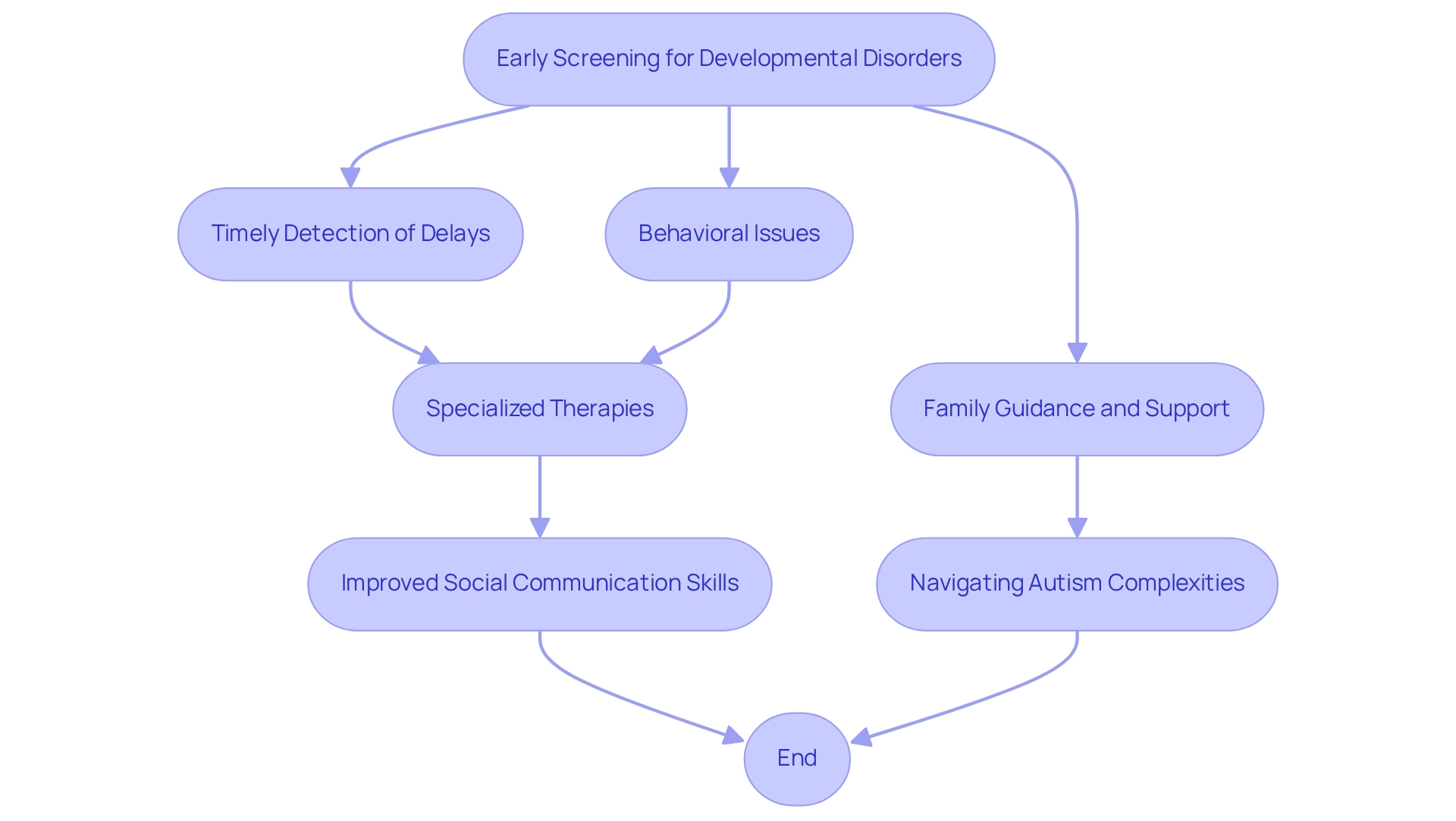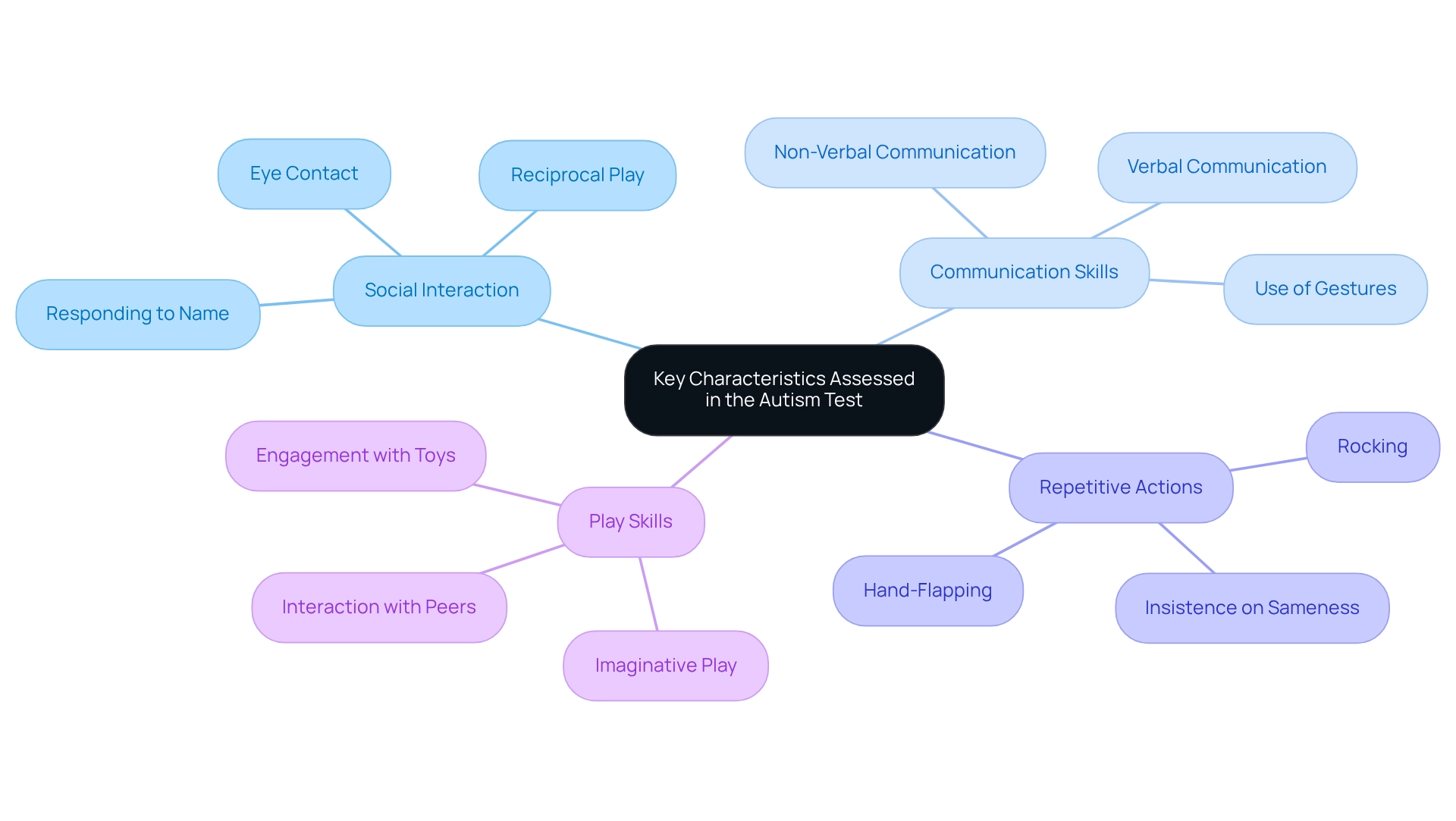Overview
The 3-year-old autism test, primarily the Modified Checklist for Autism in Toddlers (M-CHAT), plays a vital role in the early identification of Autism Spectrum Disorder (ASD) in children. This early detection is essential, as it allows for timely interventions that can significantly enhance a child's development. Understanding the characteristics evaluated by the test, such as:
- Social interaction
- Communication skills
- Play behaviors
can be incredibly beneficial for parents. It empowers them to grasp their child's developmental needs and seek out the appropriate resources for support.
As a parent, navigating the complexities of your child's development can be overwhelming. The M-CHAT provides a pathway to understanding, helping you recognize when to seek further assistance. Remember, you're not alone in this journey. Many families face similar challenges, and sharing experiences can foster a supportive community.
If you have concerns about your child's development, consider reaching out to a healthcare professional. They can guide you through the next steps and connect you with valuable resources. Together, we can ensure that every child receives the support they need to thrive.
Introduction
In a world where early intervention can profoundly influence a child's developmental journey, grasping the significance of the 3-Year-Old Autism Test is essential. This screening tool, known as the Modified Checklist for Autism in Toddlers (M-CHAT), represents a vital first step in identifying children at risk for Autism Spectrum Disorder (ASD) by their third birthday. Through a series of thoughtful questions directed at parents, the M-CHAT not only brings to light potential developmental concerns but also paves the way for timely support and intervention.
As research increasingly highlights the importance of early autism diagnosis, the implications for families and children are truly impactful. Early identification can lead to enhanced communication skills and a nurturing environment that fosters growth. By understanding the M-CHAT and its role, parents can take proactive steps towards ensuring their child's developmental needs are met, ultimately creating a brighter future for their little ones.
Define the 3-Year-Old Autism Test
The Modified Checklist for Autism in Toddlers (M-CHAT) is a vital tool designed to help parents identify whether their three-year-old may be at risk for Autism Spectrum Disorder (ASD). This screening instrument consists of a series of questions that parents can answer about their child's behavior and development. Understanding these early signs is crucial; it allows for timely intervention and support.
Prompt detection of developmental disorders can lead to better outcomes for children. By recognizing the initial indicators of ASD, parents can access early intervention strategies tailored to their child's unique needs. This proactive approach not only aids in development but also provides peace of mind for families navigating this journey.
If you have concerns about your child's development, consider utilizing the M-CHAT as a first step. Engaging with this assessment can open doors to resources and support that make a significant difference in your child's life. Remember, early action can create a brighter future for your little one.

Contextualize the Importance of Early Autism Testing
Early screening for developmental disorders is crucial, as it allows for the timely detection of developmental delays and behavioral issues when intervention can be most effective. Imagine the relief of knowing that specialized therapies can significantly enhance a young child's social communication skills and overall development, especially when identified before the age of three. Research shows that early diagnosis can lead to remarkable improvements in social symptoms within just one to two years.
Moreover, early intervention provides families with the guidance needed to navigate the complexities of autism. It equips them with essential resources and support to effectively address their child's unique needs. This proactive approach not only benefits the child but also reduces stress for families, creating a nurturing environment where growth and learning can flourish. It's a journey that families do not have to face alone; together, we can foster a brighter future for our children.

Outline the Testing Process for 3-Year-Olds
The testing procedure for the autism assessment for three-year-olds typically begins with a screening questionnaire, such as the M-CHAT. This is a tool filled out by parents, based on their observations of their child's behaviors. It includes questions that delve into the child's social interactions, communication skills, and play behaviors, helping to shed light on their development.
If the screening raises any potential concerns, a follow-up evaluation may be arranged with a qualified professional, like a pediatrician or a psychologist who specializes in autism assessments for young children. During this evaluation, the clinician will carry out a more thorough assessment. This may involve the autism test itself, direct observation of the child, structured play activities, and interviews with the parents to gather a detailed developmental history.
The entire process is designed to create a nurturing environment where parents can comfortably express their concerns and where the child can be assessed in a familiar setting. It's essential to foster this atmosphere of support, ensuring that both parents and children feel at ease throughout the evaluation.

Identify Key Characteristics Assessed in the Test
Understanding the evaluation process for autism can be overwhelming for many parents, especially when it comes to the 3-year-old autism test. This assessment is designed to evaluate several key characteristics that are indicative of autism spectrum disorder, offering valuable insights into your child's developmental journey.
One important aspect is Social Interaction. Evaluators carefully observe signs of social engagement, such as the ability to make eye contact, respond to their name, and engage in reciprocal play. These interactions are crucial for understanding how your child connects with others.
Another vital area is Communication Skills. The test assesses both verbal and non-verbal communication, including the use of gestures, the ability to express needs, and the development of language skills. These elements are essential for fostering meaningful connections and expressing thoughts and feelings.
Additionally, Repetitive Actions are noted during the evaluation. Observations regarding any repetitive movements or actions, such as hand-flapping, rocking, or insistence on sameness in routines, provide further insights into your child's behavior and preferences.
Lastly, Play Skills are evaluated to determine if your child participates in imaginative play and how they engage with toys and peers. This aspect of development is crucial, as it can highlight both strengths and areas where support may be beneficial.
These characteristics are not just numbers on a test; they represent a comprehensive view of your child's developmental profile and potential challenges. Identifying these traits early on can be instrumental in accessing early intervention services, ensuring that your child receives the support they need to thrive. If you have concerns about your child's development, consider seeking a 3-year-old autism test to gain clarity and direction on their unique journey.

Conclusion
The Modified Checklist for Autism in Toddlers (M-CHAT) is an invaluable resource for parents seeking to identify Autism Spectrum Disorder (ASD) in their children before their third birthday. Through a structured questionnaire that examines various facets of a child's development, parents can gain meaningful insights into their child's social interactions, communication skills, and play behaviors. This early screening is crucial, as it not only brings potential developmental concerns to light but also allows for timely intervention, which is vital for nurturing positive outcomes.
Research highlights the significant benefits of early autism diagnosis, showing that children who receive support before the age of three often see remarkable improvements in their social communication skills and overall growth. For families, this proactive approach not only reduces stress but also provides essential resources to help navigate the complexities of autism, fostering a nurturing environment that promotes growth and learning.
In conclusion, the 3-Year-Old Autism Test transcends being merely a screening tool; it marks a pivotal first step in ensuring that children at risk for autism receive the early intervention they deserve. By embracing and utilizing the M-CHAT, parents can actively participate in their child's developmental journey, ultimately paving the way for a brighter future. The significance of early intervention cannot be overstated, as it lays the groundwork for improved developmental trajectories and a supportive family dynamic.
Frequently Asked Questions
What is the Modified Checklist for Autism in Toddlers (M-CHAT)?
The M-CHAT is a screening tool designed to help parents identify if their three-year-old may be at risk for Autism Spectrum Disorder (ASD) through a series of questions about the child's behavior and development.
Why is it important to understand early signs of Autism Spectrum Disorder?
Recognizing early signs of ASD is crucial as it allows for timely intervention and support, which can lead to better outcomes for children.
How can early intervention strategies benefit children at risk for ASD?
Early intervention strategies can aid in a child's development and provide peace of mind for families by addressing the child's unique needs proactively.
What should parents do if they have concerns about their child's development?
Parents should consider utilizing the M-CHAT as a first step to assess their child's development, which can lead to accessing resources and support that can significantly impact their child's life.
What is the overall message regarding early action for children at risk of ASD?
Early action can create a brighter future for children at risk of ASD by facilitating timely support and intervention.




